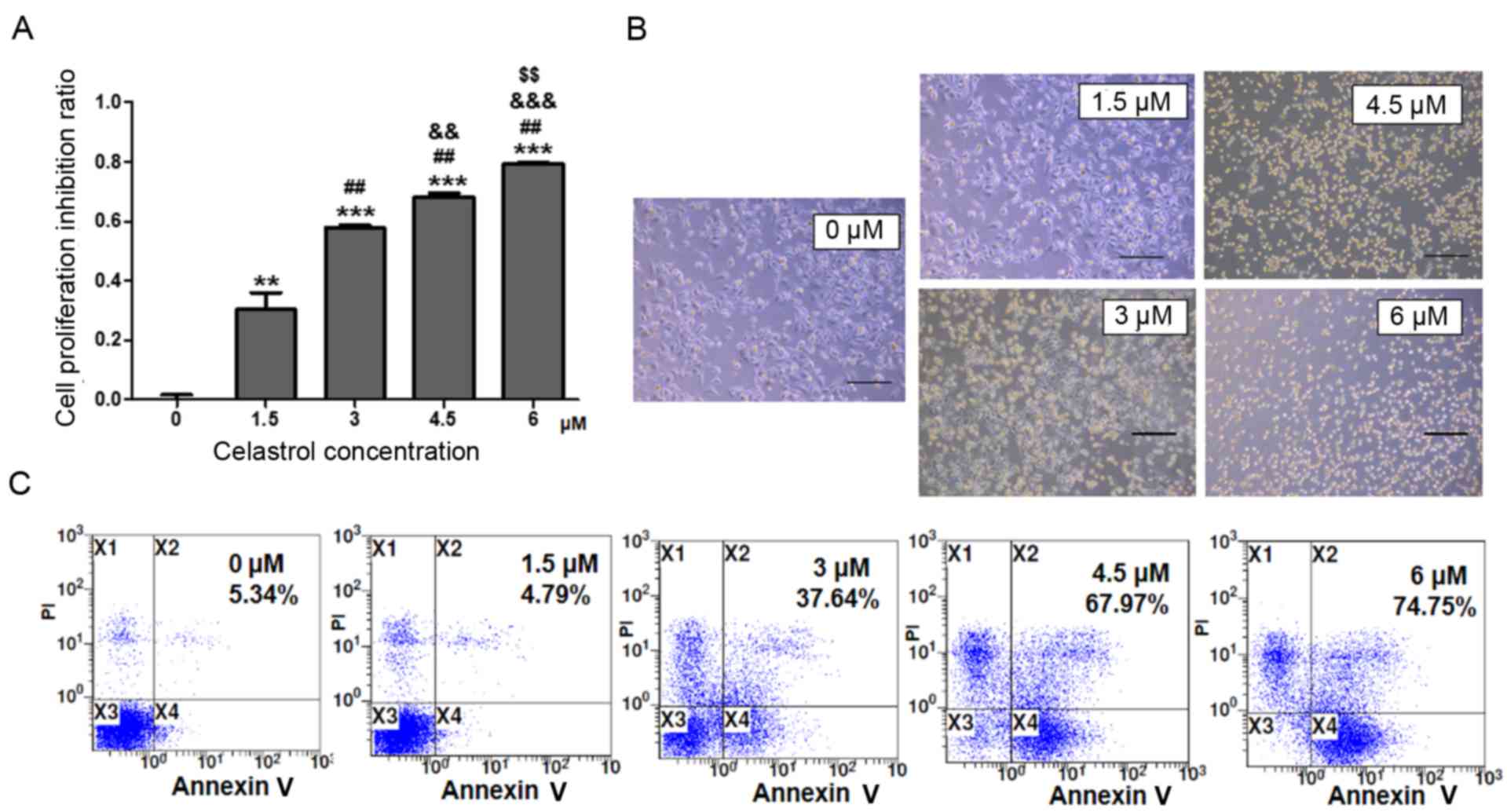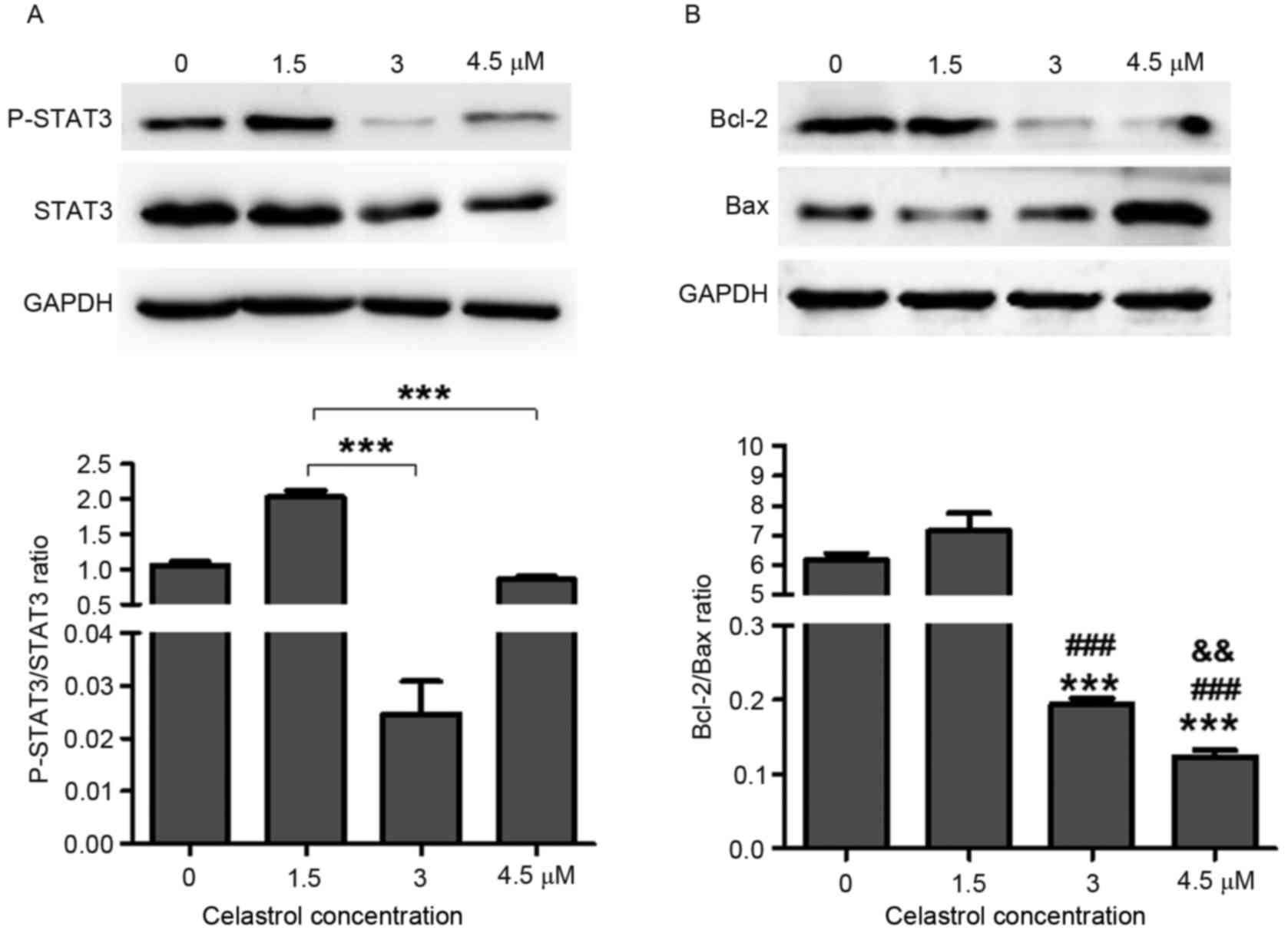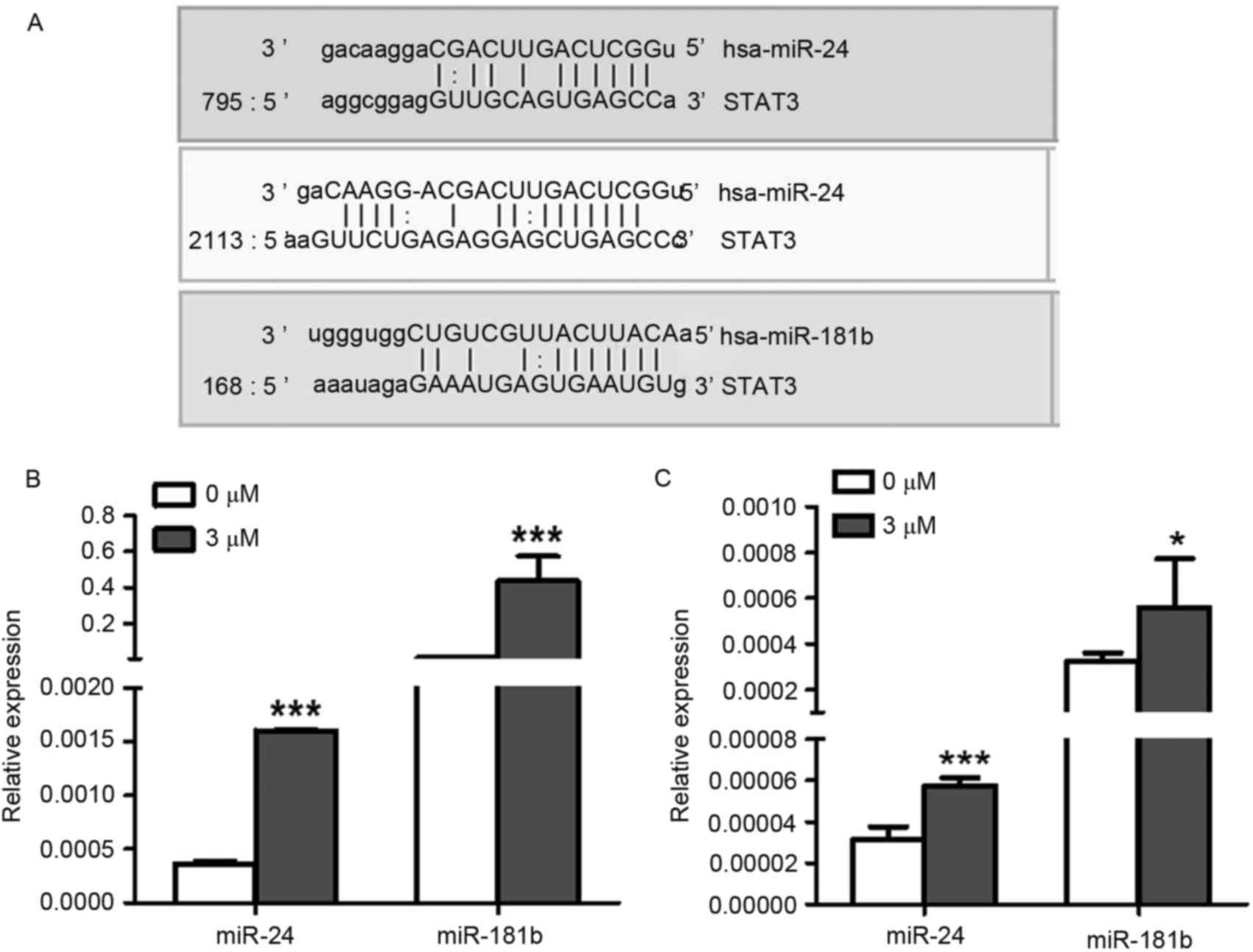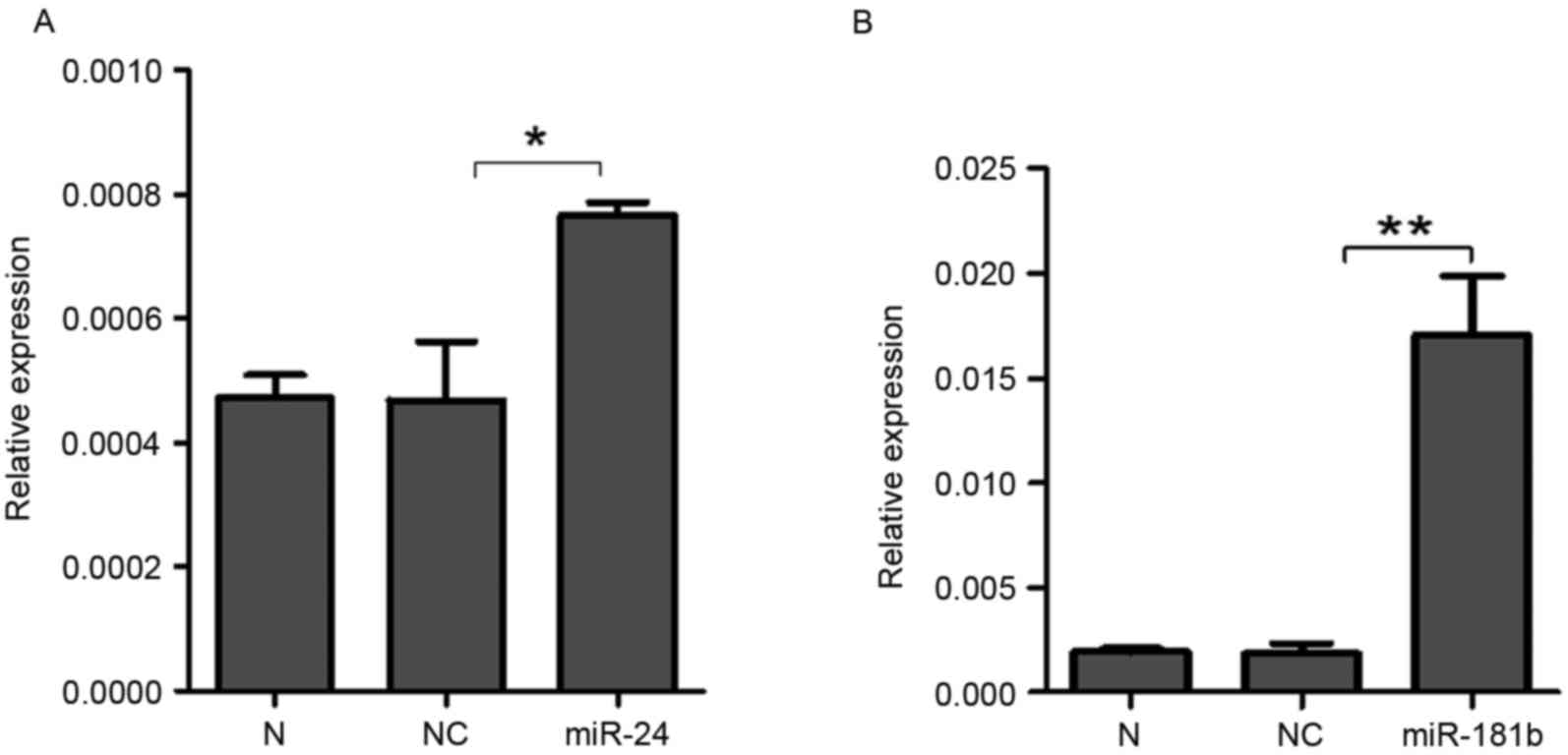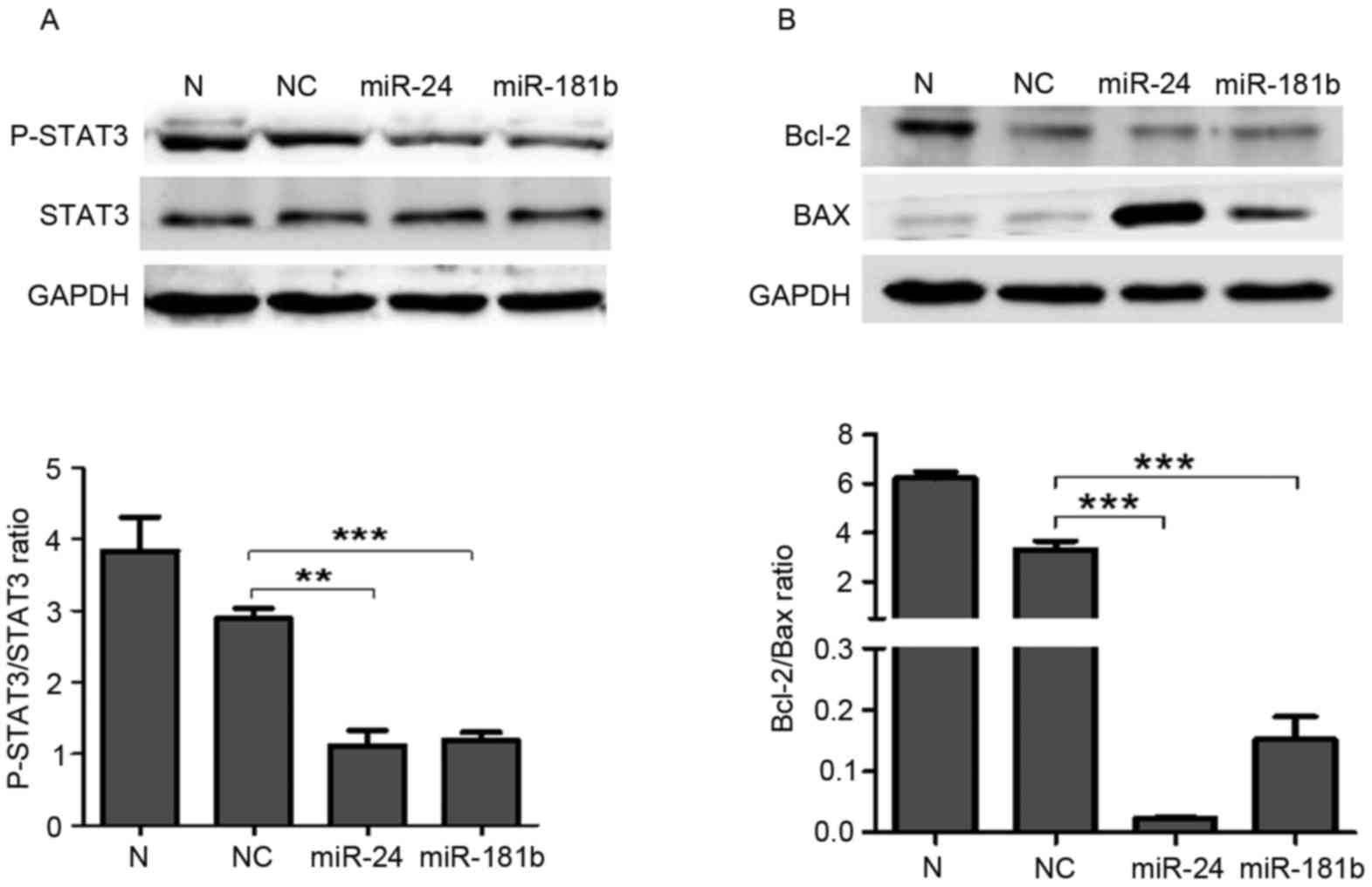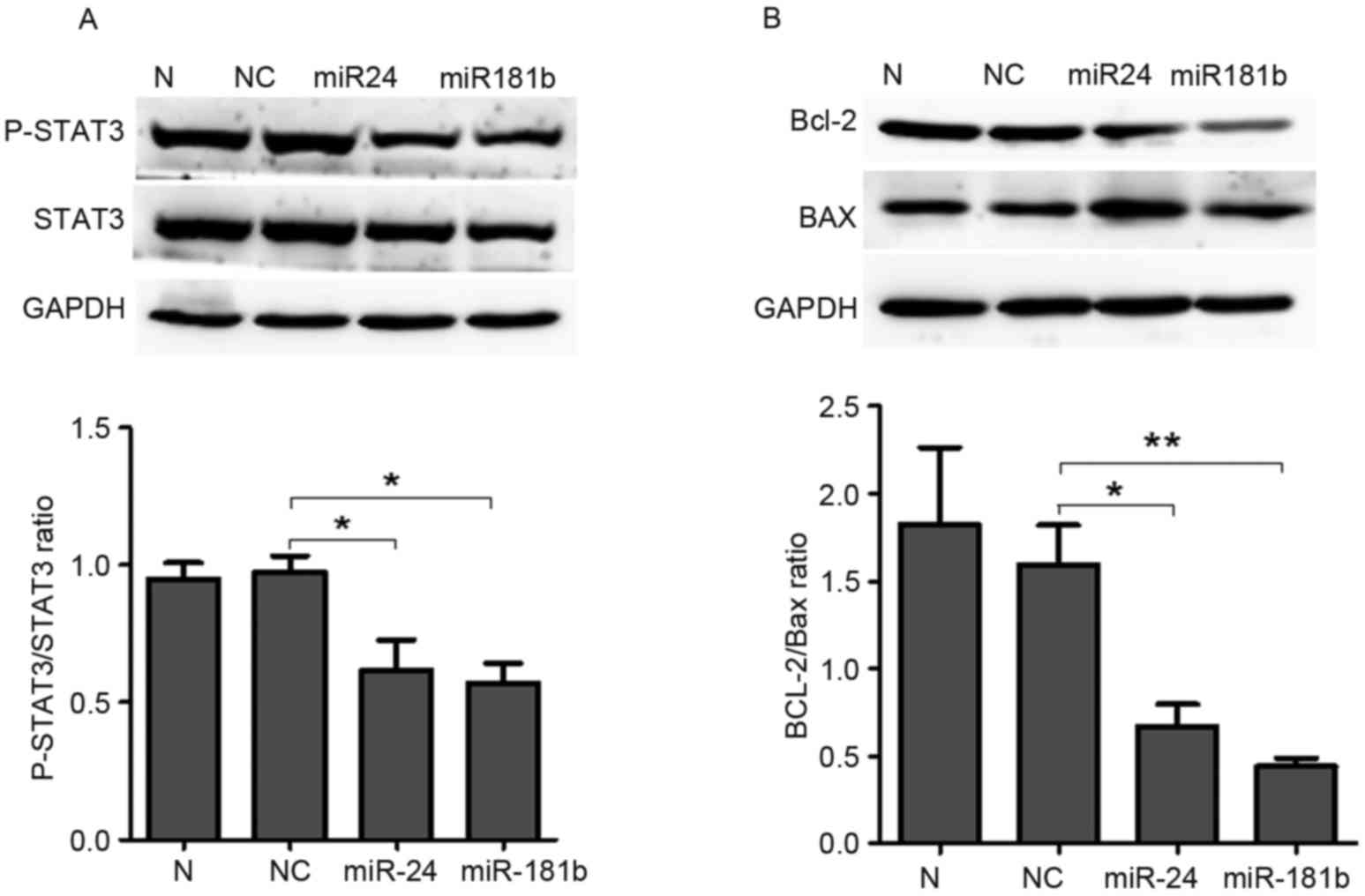Celastrol suppresses the proliferation of lung adenocarcinoma cells by regulating microRNA-24 and microRNA-181b
- Authors:
- Published online on: December 12, 2017 https://doi.org/10.3892/ol.2017.7593
- Pages: 2515-2521
Abstract
Introduction
Celastrol is a pharmacologically active compound that was originally isolated from Thunder God Vine (Tripterygium wilfordii; traditional Chinese medicine). Celastrol was identified to be a pentacyclic triterpenoid, belonging to a small category of natural products of triterpene quinine methides (1,2). Containing electrophilic sites within the rings of quinone methide structure, celastrol is able to form covalent Michael adducts with the nucleophilic thiol groups of cysteine residues (3,4). This appears to be the mechanism underlying celastrol-mediated effects on the functions of various proteins, although the structural determinants in proteins can also regulate their interaction with celastrol and the covalent adducts formation (5).
Numerous previous studies have indicated that celastrol may protect against a variety of inflammatory diseases in animal models (6,7). Furthermore, celastrol is a promising anticancer drug, which can suppress the proliferation of various cancer cells and prevent their malignant tissue invasion and obstruct angiogenesis (8–10). Certain therapeutic studies also demonstrated that celastrol can sensitize resistant melanoma cell to temozolomide treatment and potentiate radiotherapy of prostate cancer cells in combination therapy (11,12).
Signal transducer and activator of transcription 3 (STAT3) has been identified as a key molecular target of celastrol (13,14); however, the mechanism underlying the effects of celastrol on STAT3 remains to be elucidated. In therapeutic investigations of celastrol, certain studies suggest that celastrol may induce apoptosis and repress invasion of cancer cells by regulation of microRNA (miRNA) expression levels (15,16). Therefore, the present study investigated whether the STAT3 signaling pathway is associated with the expression levels of miRNAs. The present study further investigated whether celastrol inhibited lung cancer apoptosis via STAT3-associated miRNAs.
Materials and methods
Cell culture
A549 human lung adenocarcinoma cells purchased from Shanghai Institute of Pharmaceutical Industry (Shanghai, China) were cultured in RPMI-1640 supplemented with 10% fetal bovine serum (both from Gibco; Thermo Fisher Scientific, Inc., Waltham, MA, USA) and 100 U/ml penicillin-streptomycin (Sigma-Aldrich; Merck KGaA, Darmstadt, Germany) and maintained at 37°C in a humidified incubator containing 5% CO2. Cells (5×105) in the logarithmic growth phase were seeded in 6-well plates, and celastrol (Sigma-Aldrich; Merck KGaA) was dissolved in dimethyl sulfoxide (DMSO) and added to the plate in complete RPMI-1640 medium when the cell confluence arrived at 70%. Cells were incubated for 48 h at 37°C. LTEP-a-2, another human lung adenocarcinoma cell line also came from Shanghai Institute of Pharmaceutical Industry, were used under the same culture condition as A549 cells.
MTT assay
Cells (1×104) were cultured into 96-well plates. Various concentrations of celastrol (0, 1.5, 3 and 4.5 µM) were added to the medium and 6 replicates were performed for each concentration. Cells were cultivated for 48 h at 37°C, MTT assays were performed to determine the cell viability and the growth inhibition rate of A549 cells. A total of 10 µl MTT (5 mg/ml) was added to each well and the supernatant was removed by pipette after another 4 h of incubation at 37°C. Subsequently, 100 µl DMSO (Sigma-Aldrich; Merck KGaA) was added to dissolve the crystals produced by MTT at room temperature for 10 min. The optical density (OD) value was determined using an ELISA reader (ELx800; Bio-Tek Instruments, Inc., Winooski, VT, USA) at 570 nm. Cell growth inhibition rate = (OD control - OD sample)/OD control ×100 (%) (17,18).
Detection of apoptosis
Cells were cultured into 6-well plates and celastrol was added to the plate following the aforementioned concentration gradient when the cell confluence was 70% on the following day. Detection of apoptosis was performed after 48 h incubation at 37°C, according to the Annexin V-fluorescein isothiocyanate (FITC)/propidium iodide (PI) apoptosis detection kit protocol (BD Biosciences, Franklin Lakes, NJ, USA). Firstly, A549 cells were gently washed with PBS twice. Subsequently, the cells were centrifuged for 5 min at 650 × g at room temperature, the supernatant was discarded and 100 µl 1X binding buffer was added to each tube for re-suspension at room temperature. Next, 5 µl annexin V-FITC and 5 µl PI were added and cells were incubated at room temperature for 15 min. The cells were then analyzed using a flow cytometer (Beckman Coulter, Inc., Brea, CA, USA).
Reverse transcription-quantitative polymerase chain reaction (RT-qPCR)
A549 cells were treated with the effective concentration of celastrol (3 µM) for 48 h at 37°C and the control group was established using an equivalent concentration of DMSO. miRNA from these cells was isolated using RNAiso (Takara Bio, Inc., Otsu, Japan) according to the manufacturer's instruction. Subsequently, poly(A) was added using poly(A) polymerase (Ambion; Thermo Fisher Scientific, Inc.). miRNA extraction and adding poly(A) should follow the respective protocols. Complementary DNA was synthesized using RT primer 5′-AACATGTACAGTCCATGGATGd(T)30(A, G, C or T)-3′. miR primers were as follows: miR-24 forward, 5′-CTCCGGTGCCTACTGAGCTGA-3′ and reverse, 5′-AACATGTACAGTCCATGGATG-3′; miR-181b forward, 5′-GGTCACAATCAACATTCATTG-3′ and reverse, 5′-AACATGTACAGTCCATGGATG-3′. Human 5S rRNA was used as reference gene, and primers were as follows: Forward, 5′-GCCATACCACCCTGAACG-3′ and reverse, 5′-AACATGTACAGTCCATGGATG-3′. SYBR® Premix Ex Taq™ kit (Takara Bio, Inc.) was used according to the manufacturer's instructions. The expression levels of miRNA was assessed using the RG3000 system (Qiagen, Inc., Valencia, CA, USA) as follows: Initiation with 3 min of denaturation at 95°C, followed by 40 cycles of amplification with 20 sec of denaturation at 95°C, 20 sec at 56°C for annealing and 20 sec of extension at 72°C. Fluorescence was detected at 585 nm using the RG3000 system (Qiagen, Inc.). The above process was repeated 3 times in triplicate. The results ware quantified using the 2−ΔΔCq method as before (19).
Western blotting
Cells were lysed using cold lysis buffer (RIPA; Beyotime Institute of Biotechnology, Haimen, China) for 30 min on ice and protein concentration of cell lysis was determined by a BCA assay (cat no. PC0020; Beijing Solarbio Science & Technology Co., Ltd., Beijing, China). The experiment followed the manufacturer's instructions. Subsequently, each 35 µg protein sample was subjected to SDS-PAGE (12% separating gel, 5% concentrating gel) for electrophoresis and transferred to polyvinylidene difluoride membranes. Following transfer, membranes were incubated in a blocking buffer (5% non-fat milk TBST solution, TBST: NaCl 0.8%, 0.02% KCl, Tris-base 0.3%, Tween-20 0.1%, pH 7.4) for 2 h at room temperature. Subsequently, the membranes were washed 3 times with TBST (10 min each time). Next, the membranes were immunoblotted with antibodies against p-STAT-3 (1:800; sc-81523) and STAT-3 (1:800; sc-8019) (both from Santa Cruz Biotechnology, Inc., Dallas, TX, USA), Bcl-2 (1:500; BS1031), BAX (1:500; BS2538) (both from Bioworld Technology, Inc., St. Louis Park, MN, USA) and GAPDH (1:3,000; TA309157; Beijing Zhongshan Golden Bridge Biotechnology Co., Ltd., Beijing, China), which was used as the control. Immunoblotting was for 16–18 h at 4°C and then washing was performed with TBST 3 times (10 min each time). Membranes were then incubated with secondary antibodies conjugated to horseradish peroxidase (1:3000; BS13271 and BS12471; Bioworld Technology, Inc.). Blots were quantified densitometrically using Quantity One software (V4.62; Bio-Rad Laboratories, Inc., Hercules, CA, USA).
miRNAs prediction
The webpage (http://www.microrna.org/microrna/home.do) was opened, input the name of protein of interest was inputted interested in the item ‘Target mRNA’ and miRNAs with potential interaction with the protein and could be confirmed by RT-qPCR were searched for.
Statistical analysis
Quantitative results are presented as the mean ± standard deviation. Comparisons of parameters between the two groups were made using an unpaired Student's t-test or a Mann-Whitney U test. Statistical significance was evaluated with GraphPad Prism 5 (GraphPad Software, Inc., La Jolla, CA, USA). P<0.05 was considered to indicate a statistically significant difference.
Results
Celastrol inhibits proliferation and promotes apoptosis of A549 cells
To investigate the effects of celastrol on A549 cell growth, A549 cells were treated with various concentrations of celastrol for 24 h. The MTT assay indicated that A549 cell proliferation was suppressed by celastrol in a dose-dependent manner. There was a higher level of proliferation suppression of A549 cells with a higher concentration of celastrol (Fig. 1A). The microcopy examination results confirmed these findings. There were more dead and floating cells in the higher celastrol concentration-treated cultures compared with other cultures (Fig. 1B). In order to determine whether the decrease of cell number was due to apoptosis induced by celastrol, Annexin V-FITC and PI staining was performed. The results revealed that celastrol induced A549 cell apoptosis in a dose-dependent manner (Fig. 1C). In the concentration cascade, 3 µM celastrol was the closest to ID50, thus 3 µM celastrol was selected as the most reasonable concentration in this study.
Celastrol decreases STAT3 phosphorylation and Bcl-2/Bax ratio
Previous studies have revealed the role of celastrol in the prevention of cancer growth, in which numerous targets of celastrol were identified, including STAT3 (2,9,10,17). To further investigate the role of celastrol in lung cancer, STAT3 expression was detected in A549 cells following treatment with various concentrations of celastrol. The results demonstrated that 3 µM (P<0.0001) and 4.5 µM (P=0.0003) celastrol treatment significantly reduced STAT3 phosphorylation in A549 cells compared with 1.5 µM treatment (Fig. 2A).
STAT3 serves a critical role in cell proliferation and survival. It has been revealed that deactivation of STAT3 abrogates the anti-apoptotic advantage (such as via radioresistance and chemoresistance) in various types of tumor cell lines, mainly due to the attenuation of Bcl-2 (18,20). Deactivation of the STAT3 signaling pathways by celastrol induced tumor cell apoptosis (Fig. 1C). The Bcl-2/Bax ratio was significantly decreased in 3 µM (P<0.0001) and 4.5 µM (P<0.0001) celastrol-treated cells compared with 0 and 1.5 µM celastrol-treated groups (Fig. 2B). Indeed, 4.5 µM P=0.006) celastrol treatment also could lead Bcl-2/Bax ratio decreased compared with 3 µM treatment (Fig. 2B). These results further suggested higher concentration celastrol treatment attenuated Bcl-2/Bax ratio more within certain scope. The apoptosis induced by celastrol may account for deactivation of the STAT3 signaling pathway.
Celastrol induces the overexpression of miR-24 and miR-181b
The molecular mechanisms underlying celastrol induction of apoptosis require further elucidation. Therefore the mechanisms underlying the effect of celastrol on STAT3 phosphorylation was investigated. Previous studies have revealed that miRNAs are involved in the antitumor mechanism underlying celastrol (15,16). Therefore, the present study investigated whether celastrol induced A549 cell apoptosis through the regulation of STAT3-associated miRNAs.
Using microRNA.org software (http://www.microrna.org/microrna/home.do), the present study predicted that the 3′ untranslated region (UTR) of STAT3 mRNA was targeted by miR-24 and miR-181b (Fig. 3A). Furthermore, the expression levels of miR-24 (P<0.0001) and miR-181b (P=0.0006) were both significantly increased in 3 µM celastrol-treated A549 cells compared with the control treatment (Fig. 3B), indicating that celastrol may decrease the expression level of STAT3 via up-regulation of miR-24 and miR-181b. Additionally, LTEP-a-2 cells were also used to confirm the effects of celastrol on the expression levels of miR-24 and miR-181b with 3 µM celastrol stimulation. As expected, miR-24 (P=0.0005) and miR-181b (P=0.03) were upregulated in celastrol-treated LTEP-a-2 cells (Fig. 3C).
STAT3 phosphorylation and Bcl-2/Bax ratio is suppressed by miR-24 and miR-181b
To further investigate the effects of miR-24 and miR-181b on STAT3, synthesized miR-24 and miR-181b was transfected into A549 cells. RT-qPCR demonstrated that the expression levels of miR-24 (P=0.04, Fig. 4A) and miR-181b (P=0.006, Fig. 4B) significantly increased in the A549 cells treated with miR-24 and miR-181b compared with the negative control group, which indicated that miR-24 and miR-181b were successfully transfected into A549 cells. Western blotting revealed that miR-24 (P=0.002) and miR-181b (P=0.0007) treatment significantly suppressed the p-STAT3 levels compared with the negative control group (Fig. 5A). Furthermore, miR-24 (P=0.0008) and miR-181b (P=0.0009) significantly decreased the expression ratio of Bcl-2 and Bax compared with the negative control group (P<0.001; Fig. 5B).
LTEP-a-2 cells were used to confirm these results. MiR-24 and miR-181b treatment significantly increased the level of miR-24 (P=0.04, Fig. 6A) and miR-181b (P=0.04, Fig. 6B) compared with the negative control group and significantly decreased p-STAT3 compared with the negative control group (P=0.04 for miR-24 and P=0.04 for miR-181b; Fig. 7A). In addition, miR-24 (P=0.03, Fig. 7B) and miR-181b (P=0.006, Fig. 7B) treatment significantly decreased the Bcl-2/Bax ratio compared with the control group in LTEP-a-2 cells. These results suggested that miR-24 and miR-181b mediated the effects of celastrol on the phosphorylation levels of STAT3 and the Bcl-2/Bax ratio.
Discussion
Previously, natural preparation represented a significant portion of the pharmaceutical market compared with synthesized compounds (2–4). Celastrol is extracted from Thunder God Vine, which contains a number of therapeutic active compounds (2). Since the 1970s, celastrol has been identified to possess anti-inflammatory, anti-oxidative and tumor cell-inducing apoptotic properties. Furthermore, compared with other anticancer drugs, celastrol selectively targets tumor cells and causes no obvious damage to normal hematopoietic cells, the heart, liver, kidney or other organs (20–22). Therefore, celastrol is considered to be a relatively safe and effective anticancer drug. Cumulative studies have identified numerous molecular targets of celastrol; however, studies investigating how celastrol affects these targets are rare. The present study treated the A549 lung adenocarcinoma cell line with various concentrations of celastrol to observe these effects. The results suggested that celastrol suppresses the proliferation and induces apoptosis of A549 cells in a dose-dependent manner. Of note, it was revealed that STAT3-associated miRNAs participated in the process of celastrol-mediated induction of A549 cell apoptosis.
STAT3 is a transcription factor that is phosphorylated by Janus kinases in response to cytokine activation (23). Subsequently, it dimerizes and translocates to the nucleus to activate transcription of cytokine-responsive genes (24). In tumorigenesis, STAT3 activation induces tumor progression by promoting the cell cycle and preventing apoptosis (12,23). The present study demonstrated that celastrol induces cell apoptosis by decreasing the levels of STAT3 phosphorylation.
Furthermore, Bcl-2 and Bax have been reported to be downstream factors of STAT3, and they serve important roles in the mitochondrial-mediated apoptosis pathway (18,20). Bcl-2 is an anti-apoptotic protein and Bax is a pro-apoptotic protein. Apoptosis is largely controlled by the balance between anti-apoptotic and pro-apoptotic proteins, including the Bcl-2/Bax ratio. In the present study, celastrol significantly decreased STAT3 phosphorylation and the Bcl-2/Bax ratio, which supported the hypothesis that celastrol induces apoptosis by affecting the expression of STAT3 phosphorylation and the Bcl-2/Bax ratio.
Certain studies have demonstrated that celastrol may influence the expression levels of numerous miRNAs and achieve the therapeutic effects via these miRNAs (15,16), which regulate a number of gene expression levels by targeting the 3′-UTR of mRNA molecules. To further investigate whether celastrol affected the expression of STAT3-associated miRNAs, miRNA analysis software was used to predict that the 3′-UTR of STAT3 was targeted by miR-24 and miR-181b. Previous studies indicated that miR-24 may regulate liver inflammation in rats and that miR-181b functions as a tumor suppressor in glioma (25,26). Of note, the present study revealed that p-STAT3 was significantly reduced by miR-24 and miR-181b. In addition, the Bcl-2/Bax ratio also decreased in miR-24 and miR-181b-treated cells. These results confirmed that miR-24 and miR-181b may influence STAT3 activation (27). Furthermore, celastrol treatment increased the expression levels of miR-24 and miR-181b, and decreased STAT3 phosphorylation and the Bcl-2/Bax ratio. These results indicated that celastrol may decrease p-STAT3 levels by regulating miR-24 and miR-181b.
In conclusion, the present study investigated the molecular mechanism underlying celastrol in lung cancer therapy. It was demonstrated that celastrol induced apoptosis of lung cancer cells by affecting the expression levels of miR-24 and miR-181b, which further regulated the activation of STAT3. Identification of the function of miR-24 and miR-181b provides useful information for the safe and effective application of celastrol in tumor therapy.
Acknowledgements
The present study was supported by the National Natural Science Foundation (grant nos. 31371321, 31440061 and 81530060), and the Shandong Science and Technology Committee (grant nos. ZR2014HP004, 2015GSF118073, ZR2014HL055 and ZR2013HL003), the Health and Family Planning Commission of Shandong Province (grant no. 2014WS0185) and the Shandong Education Department (grant no. J13LE11).
References
|
Salminen A, Lehtonen M, Paimela T and Kaarniranta K: Celastrol: Molecular targets of thunder god vine. Biochem Biophys Res Commun. 394:439–442. 2010. View Article : Google Scholar : PubMed/NCBI | |
|
Li-Weber M: Targeting apoptosis pathways in cancer by Chinese medicine. Cancer Lett. 332:304–312. 2013. View Article : Google Scholar : PubMed/NCBI | |
|
Corson TW and Crews CM: Molecular understanding and modern application of traditional medicines: Triumphs and trials. Cell. 130:769–774. 2007. View Article : Google Scholar : PubMed/NCBI | |
|
Patwardhan B and Mashelkar RA: Traditional medicine-inspired approaches to drug discovery: Can Ayurveda show the way forward? Drug Discov Today. 14:804–811. 2009. View Article : Google Scholar : PubMed/NCBI | |
|
Koehn FE: High impact technologies for natural products screening. Prog Drug Res. 65:175, 177–210. 2008. | |
|
Lipsky PE and Tao XL: A potential new treatment for rheumatoid arthritis: Thunder god vine. Semin Arthritis Rheum. 26:713–723. 1997. View Article : Google Scholar : PubMed/NCBI | |
|
Canter PH, Lee HS and Ernst E: A systematic review of randomised clinical trials of Tripterygium wilfordii for rheumatoid arthritis. Phytomedicine. 13:371–377. 2006. View Article : Google Scholar : PubMed/NCBI | |
|
Petronelli A, Pannitteri G and Testa U: Triterpenoids as new promising anticancer drugs. Anticancer Drugs. 20:880–892. 2009. View Article : Google Scholar : PubMed/NCBI | |
|
Sethi G, Ahn KS, Pandey MK and Aggarwal BB: Celastrol, a novel triterpene, potentiates TNF-induced apoptosis and suppresses invasion of tumor cells by inhibiting NF-kappaB-regulated gene products and TAK1-mediated NF-kappaB activation. Blood. 109:2727–2735. 2007.PubMed/NCBI | |
|
Yang H, Chen D, Cui QC, Yuan X and Dou QP: Celastrol, a triterpene extracted from the Chinese ‘Thunder of God Vine,’ is a potent proteasome inhibitor and suppresses human prostate cancer growth in nude mice. Cancer Res. 66:4758–4765. 2006. View Article : Google Scholar : PubMed/NCBI | |
|
Chen M, Rose AE, Doudican N, Osman I and Orlow SJ: Celastrol synergistically enhances temozolomide cytotoxicity in melanoma cells. Mol Cancer Res. 7:1946–1953. 2009. View Article : Google Scholar : PubMed/NCBI | |
|
Dai Y, DeSano JT, Meng Y, Ji Q, Ljungman M, Lawrence TS and Xu L: Celastrol potentiates radiotherapy by impairment of DNA damage processing in human prostate cancer. Int J Radiat Oncol Biol Phys. 74:1217–1225. 2009. View Article : Google Scholar : PubMed/NCBI | |
|
Rajendran P, Li F, Shanmugam MK, Kannaiyan R, Goh JN, Wong KF, Wang W, Khin E, Tergaonkar V, Kumar AP, et al: Celastrol suppresses growth and induces apoptosis of human hepatocellular carcinoma through the modulation of STAT3/JAK2 signaling cascade in vitro and in vivo. Cancer Prev Res (Phila). 5:631–643. 2012. View Article : Google Scholar : PubMed/NCBI | |
|
Costantino L and Barlocco D: STAT 3 as a target for cancer drug discovery. Curr Med Chem. 15:834–843. 2008. View Article : Google Scholar : PubMed/NCBI | |
|
Sha M, Ye J, Zhang LX, Luan ZY, Chen YB and Huang JX: Celastrol induces apoptosis of gastric cancer cells by miR-21 inhibiting PI3K/Akt-NF-κB signaling pathway. Pharmacology. 93:39–46. 2014. View Article : Google Scholar : PubMed/NCBI | |
|
Li H, Li Y, Liu D, Sun H and Liu J: MiR-224 is critical for celastrol-induced inhibition of migration and invasion of hepatocellular carcinoma cells. Cell Physiol Biochem. 32:448–458. 2013. View Article : Google Scholar : PubMed/NCBI | |
|
Wang PY, Sun YX, Zhang S, Pang M, Zhang HH, Gao SY, Zhang C, Lv CJ and Xie SY: Let-7c inhibits A549 cell proliferation through oncogenic TRIB2 related factors. FEBS Lett. 587:2675–26812013. View Article : Google Scholar : PubMed/NCBI | |
|
You S, Li R, Park D, Xie M, Sica GL, Cao Y, Xiao ZQ and Deng X: Disruption of STAT3 by niclosamide reverses radioresistance of human lung cancer. Mol Cancer Ther. 13:606–616. 2014. View Article : Google Scholar : PubMed/NCBI | |
|
Livak KJ and Schmittgen TD: Analysis of relative gene expression data using real-time quantitative PCR and the 2(-Delta Delta C(T)) method. Methods. 25:402–408. 2001. View Article : Google Scholar : PubMed/NCBI | |
|
Real PJ, Sierra A, De Juan A, Segovia JC, Lopez-Vega JM and Fernandez-Luna JL: Resistance to chemotherapy via Stat3-dependent overexpression of Bcl-2 in metastatic breast cancer cells. Oncogene. 21:7611–7618. 2002. View Article : Google Scholar : PubMed/NCBI | |
|
Zhang C, Chi YL, Wang PY, Wang YQ, Zhang YX, Deng J, Lv CJ and Xie SY: miR-511 and miR-1297 inhibit human lung adenocarcinoma cell proliferation by targeting oncogene TRIB2. PLoS One. 7:e460902012. View Article : Google Scholar : PubMed/NCBI | |
|
Li YJ, Zhang YX, Wang PY, Chi YL, Zhang C, Ma Y, Lv CJ and Xie SY: Regression of A549 lung cancer tumors by anti-miR-150 vector. Oncol Rep. 27:129–134. 2012.PubMed/NCBI | |
|
Ji N, Li J, Wei ZKong F, Jin H, Chen X, Li Y and Deng Y: Effect of celastrol on growth inhibition of prostate cancer cells through the regulation of hERG channel in vitro. Biomed Res Int. 2015:3084752015. View Article : Google Scholar : PubMed/NCBI | |
|
DiSanto JP: Cytokines: Shared receptors, distinct functions. Curr Biol. 7:R424–R426. 1997. View Article : Google Scholar : PubMed/NCBI | |
|
Dogan I, Cumaoglu A, Aricioglu A and Ekmekci A: Inhibition of ErbB2 by herceptin reduces viability and survival, induces apoptosis and oxidative stress in Calu-3 cell line. Mol Cell Biochem. 347:41–51. 2011. View Article : Google Scholar : PubMed/NCBI | |
|
Tian SS, Lamb P, Seidel HM and RBRosen J Stein: Rapid activation of the STAT3 transcription factor by granulocyte colony-stimulating factor. Blood. 84:1760–1764. 1994.PubMed/NCBI | |
|
Cao Q, Li YY, He WF, Zhang ZZ, Zhou Q, Liu X, Shen Y and Huang TT: Interplay between microRNAs and the STAT3 signaling pathway in human cancers. Physiol Genomics. 45:1206–1214. 2013. View Article : Google Scholar : PubMed/NCBI |



